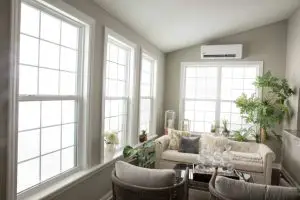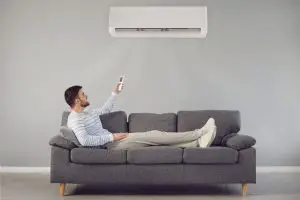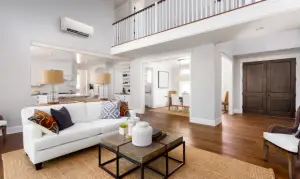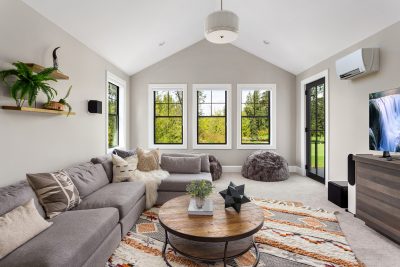When it comes to efficiently cooling or heating your living space, mini-split systems have gained immense popularity due to their energy-saving features and compact design. These versatile HVAC solutions are ideal for a variety of settings, from small apartments to spacious homes and offices.
However, selecting the right size mini split is crucial to ensure optimal performance and comfort. In this guide, we will explore what size mini split do i need and the factors that determine what size mini split you need, enabling you to make an informed decision and enjoy the perfect climate control solution tailored to your specific requirements.
What size mini split do i need?

The size of mini split you need depends on the square footage of the room or area you want to cool. A good rule of thumb is to multiply the square footage by 25 to get the BTU rating you need. So, for a 1,000 square foot room, you would need a 25,000 BTU mini split.
However, there are other factors that can affect the size of mini split you need, such as the climate, the insulation in your home, and the number of people in the room. If you live in a hot climate, you will need a larger mini split than if you live in a cooler climate.
If your home is well-insulated, you will need a smaller mini split than if your home is poorly insulated. And if there are more people in the room, you will need a larger mini split to keep everyone comfortable.
If you are not sure what size mini split you need, it is always best to consult with a qualified HVAC contractor. They can help you assess your needs and recommend the right size mini split for your home.
What size mini split is best for my room?
To determine the best size mini-split for your room, you’ll need to consider the room’s square footage, insulation quality, ceiling height, sun exposure, and local climate. The size of the mini-split is measured in British Thermal Units (BTUs) per hour. An undersized unit won’t effectively cool or heat the room, while an oversized unit can lead to inefficiency and temperature fluctuations.
Here’s a general guideline to help you choose the right size:
- Calculate the room’s square footage: Measure the length and width of your room and multiply these dimensions to get the square footage.
- Consider the insulation: If your room has excellent insulation (good windows, doors, and walls), you can choose a mini-split with slightly lower BTUs. For poor insulation, go for slightly higher BTUs.
- Account for ceiling height: If your ceiling is higher than the standard 8 feet, you may need to adjust the BTU capacity accordingly. Generally, add around 10% capacity for each additional foot of ceiling height.
- Factor in sun exposure: If your room gets a lot of direct sunlight, you might need a higher BTU capacity, as it can significantly increase the cooling load.
- Account for the local climate: In hot climates, you may require more cooling capacity, while in colder regions, heating capacity becomes more important.
Now, let’s look at some general guidelines for BTU capacity based on room size:
- Small rooms (up to 150 sq. ft.): 5,000 to 6,000 BTUs
- Medium rooms (150 to 350 sq. ft.): 7,000 to 10,000 BTUs
- Large rooms (350 to 550 sq. ft.): 12,000 to 18,000 BTUs
- Extra-large rooms (550 to 1,000 sq. ft.): 18,000 to 24,000 BTUs
Keep in mind that these are general estimates, and it’s best to consult with a professional HVAC installer to get a precise recommendation based on your specific room and requirements.
They can perform a more detailed assessment and consider other factors that might impact the unit’s efficiency, such as local climate conditions and your preferred temperature settings.
Factors influencing mini split size?
The size of a mini-split system is determined by various factors that influence the cooling or heating capacity needed for the space. Here are the key factors that influence the mini-split size:
- Room Size: The square footage of the room is one of the most critical factors in determining the mini-split size. Larger rooms require higher cooling or heating capacity, while smaller rooms need smaller units.
- Insulation Quality: The level of insulation in the room affects how much cooling or heating capacity is required. Well-insulated rooms can retain temperature better, so they may need a smaller mini-split compared to poorly insulated spaces.
- Ceiling Height: Higher ceilings result in increased volume, which means more air to cool or heat. Taller ceilings may require a higher capacity mini-split to accommodate the additional space.
- Sun Exposure: Rooms that receive a lot of direct sunlight can get considerably warmer, increasing the cooling load. Such rooms might need a larger mini-split to offset the heat gain from sunlight.
- Climate: The local climate plays a significant role in determining the mini-split size. Hotter climates typically require higher cooling capacities, while colder climates need more heating capacity.
- Number of Occupants: The number of people occupying the room can generate additional heat. A room with multiple occupants may need a larger mini-split to maintain comfort.
- Appliances and Equipment: Heat-generating appliances like computers, ovens, and lighting can increase the cooling load. Factoring in these heat sources is important when determining the mini-split size.
- Room Function: The purpose of the room matters. For example, a kitchen may require more cooling capacity due to cooking heat, while a bedroom may need less.
- Airflow: The layout of the room and airflow patterns influence how effectively the mini-split can distribute conditioned air. Proper airflow ensures even cooling or heating throughout the space.
- Desired Temperature Range: If you prefer maintaining a lower temperature during hot weather or a higher temperature during cold weather, it can impact the required mini-split size.
Considering all these factors, it’s essential to consult with a professional HVAC installer or technician who can conduct a thorough assessment of your specific needs and recommend the appropriate mini-split size for your space. An accurately sized mini-split will ensure optimal comfort and energy efficiency.
Consequences of wrong mini split size?

The consequences of having the wrong size mini split can be significant, including:
- Inadequate cooling. If the mini split is too small, it will not be able to cool the room effectively. This can lead to uncomfortable temperatures and even health problems, such as heat exhaustion.
- High energy bills. A mini split that is too small will have to work harder to cool the room, which will increase your energy bills.
- Shorter lifespan. A mini split that is too small will be under a lot of stress, which can shorten its lifespan.
- Noise pollution. A mini split that is too small may have to run for longer periods of time, which can increase noise pollution.
On the other hand, if the mini split is too large, it can also cause problems. These include:
- Short cycling. A mini split that is too large will cool the room too quickly, which can cause it to turn on and off repeatedly. This can shorten the lifespan of the unit and waste energy.
- Inefficient cooling. A mini split that is too large will not be able to dehumidify the air as effectively, which can lead to uncomfortable levels of humidity.
- Moisture problems. If a mini split is too large, it can cause moisture problems, such as mold growth.
The best way to avoid these problems is to have a qualified HVAC contractor size the mini split correctly for your needs. They will consider factors such as the size of the room, the climate, and the insulation level to determine the right size unit for you.
Different sizes for cooling and heating?
Yes, mini-split systems are available in different sizes for cooling and heating. The cooling and heating capacities of a mini-split are measured in British Thermal Units (BTUs) per hour. Due to varying demands for cooling and heating in different climates and seasons, mini-splits can be designed with different BTU capacities for each mode.
In regions with hot summers and mild winters, the cooling capacity may be higher than the heating capacity. Conversely, in colder climates with harsh winters, the heating capacity might be prioritized over the cooling capacity.
Here are some common scenarios where mini-splits may have different cooling and heating capacities:
- Cooling Dominant Systems: These mini-splits have higher cooling capacity than heating capacity. They are suitable for regions with hot summers and mild winters, where cooling is the primary concern.
- Heating Dominant Systems: These mini-splits have higher heating capacity than cooling capacity. They are ideal for colder climates where efficient heating is crucial, and cooling demands are relatively lower.
- Balanced Systems: Some mini-splits are designed to provide balanced cooling and heating capacities. These systems are suitable for regions with more moderate climates, where both cooling and heating are required throughout the year.
Mini-split systems achieve cooling and heating through the same outdoor condenser unit but using different refrigerant flow and heat exchange methods. They are equipped with a reversing valve that allows them to switch between cooling and heating modes, making them versatile and efficient for year-round comfort.
When choosing a mini-split system with different cooling and heating capacities, consider your local climate, seasonal temperature variations, and your comfort preferences. Consulting with a professional HVAC technician can help you select the right mini-split size that best suits your needs and ensures efficient operation in both cooling and heating modes.
Avoiding over/under-sizing mini split?

Avoiding over-sizing or under-sizing a mini-split system is crucial to ensure optimal performance, energy efficiency, and long-term comfort. Here are some tips to avoid these issues:
- Proper Sizing Calculation: Have a professional HVAC technician perform a detailed load calculation for your space. The calculation takes into account factors like room size, insulation, ceiling height, sun exposure, climate, and other relevant variables to determine the appropriate cooling and heating capacity needed.
- Avoid Rule of Thumb: Avoid using rough estimates or “rule of thumb” methods for sizing mini-splits. Each space is unique, and a precise calculation is essential to avoid inefficiencies.
- Insulation and Sealing: Ensure that your space is well-insulated and properly sealed. Good insulation reduces the cooling or heating load, preventing over-sizing. It also helps maintain a comfortable indoor temperature and reduces the workload on the mini-split.
- Consider Zoning: If you have multiple rooms or zones to cool and heat, consider using multi-zone or ductless mini-split systems. Zoning allows you to control the temperature in individual areas, avoiding the need to over-condition unoccupied spaces.
- Consult Manufacturer’s Guidelines: Refer to the manufacturer’s guidelines and specifications for the mini-split system you are considering. They often provide sizing recommendations based on different factors.
- Professional Installation: Have the mini-split system installed by a licensed and experienced HVAC professional. Proper installation ensures that the system operates at its best efficiency and performance levels.
- Consider Load Variations: Consider how the cooling or heating load may vary throughout the year. In some climates, a slightly oversized unit may be suitable to handle extreme temperature conditions, but extreme oversizing should be avoided.
- Balance Cooling and Heating Capacities: If you live in a region with significant seasonal variations, try to balance the cooling and heating capacities of the mini-split to meet your needs year-round.
- Regular Maintenance: Keep your mini-split system well-maintained to ensure it operates efficiently. Clean filters, proper refrigerant levels, and well-functioning components contribute to better performance.
By following these guidelines and seeking professional advice, you can avoid over-sizing or under-sizing your mini-split system, leading to a more comfortable and energy-efficient indoor environment.
Recommended:
- How much does a barbell weigh?
- How much does a mattress weigh?
- How much is turf per square foot?
- How much does a pallet of water weigh?
Conclusion
On this page, you will get to learn about what size mini split do i need. To determine the size of the mini-split you need, it’s essential to consider the square footage of your room, the quality of insulation, ceiling height, sun exposure, local climate, and other factors like the number of occupants and heat-generating appliances.
Avoid rough estimates and consult a professional HVAC technician to perform a precise load calculation. Proper sizing ensures optimal performance, energy efficiency, and long-term comfort for your space.


